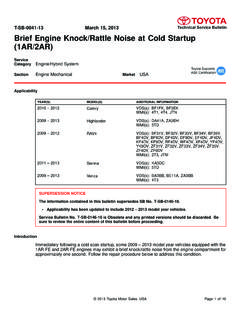Transcription of Gendered Media: The Influence of Media on Views …
1 From Gendered Lives: Communication, Gender, and Culture by Julie Chapter 9, pp. 231-244. 1994. Reprinted with 3 1 permission of Wadsworth Publishing, a division of Thomson Learning. Fax Gendered Media : The Influence of Media on Views of Gender Julia T. Wood Department of Communication, University of North Carolina at Chapel THEMES IN Media Of the many influences on how we view men and women, Media are the most pervasive and one of the most powerful. Woven throughout our daily lives, Media insinuate their messages into our consciousness at every turn.
2 All forms of Media communicate images of the sexes, many of which perpetuate unrealistic, stereotypical, and limiting perceptions. Three themes describe how Media represent gender. First, women are underrepresented which falsely implies that men are the cultural standard and women are unimportant or invisible. Second, men and women are portrayed in stereotypical ways that reflect and sustain socially endorsed Views of gender. Third, depictions of relationships between men and women emphasize traditional roles and normalize violence against women.
3 We will consider each of these themes in this section. Underrepresentation of Women A primary way in which Media distort reality is in underrepresenting women. Whether it is prime-time tele-vision, in which there are three times as many white men as women (Basow, 1992 p. 159), or children s program-ming, in which males outnumber females by two to one, or newscasts, in which women make up 16% of newscasters and in which stories about men are included 10 times more often than ones about women ( Study Reports Sex Bias, 1989), Media misrepresent actual pro-portions of men and women in the population.
4 This constant distortion tempts us to believe that there really are more men than women and, further, that men are the cultural standard. Media S MISREPRESENTATION OF AMERICAN LIFE The Media present a distorted version of cultural life in our country. According to Media portrayals: White males make up two-thirds of the popula-tion. The women are less in number, perhaps be-cause fewer than 10% live beyond 35. Those who do, like their younger and male counterparts, are nearly all white and heterosexual.
5 In addition to being young, the majority of women are beautiful, very thin, passive, and primarily concerned with relationships and getting rings out of collars and commodes. There are a few bad, bitchy women, and they are not so pretty, not so subor-dinate, and not so caring as the good women. Most of the bad ones work outside of the home, which is probably why they are hardened and un-desirable. The more powerful, ambitious men oc-cupy themselves with important business deals, exciting adventures, and rescuing dependent fe-males, whom they often then assault sexually.
6 I LIVING WITH Media Other myths about what is standard are similarly fortified by communication in Media . Minorities are even less visible than women, with African-Americans appearing only rarely (Gray, 1986; Stroman, 1989) and other ethnic minorities being virtually nonexistent. In children's programming when African-Americans do appear, almost invariably they appear in supporting roles rather than as main characters (O'Connor, 1989). While more African-Americans are appearing in prime-time television, they are too often cast in stereotypical roles.
7 In the 1992 season, for instance, 12 of the 74 series on commercial networks included large African-American casts, yet most featured them in stereotypical roles. Black men are presented as lazy and unable to handle authority as lecherous, and/or as unlawful, while females are portrayed as domineering or as sex objects ("Sights Sounds, and Stereotypes," 1992). Writing in 1993, David Evans (1993, p. 10) criticized television for stereotyping black males as athletes and entertainers.
8 These roles_ wrote Evans, mislead young black male viewers into thinking success "is only a dribble or dance step away" and blind them to other, more realistic ambitions. Hispanics and Asians are nearly absent, and when they are presented it is usually as villains or criminals (Lichter, Lichter, Rothman, Sr Amundson, 1987). Also under-represented is the single fastest growing group of Americans- older people. As a country, we are aging so that people over 60 make up a major part of our population; within this group, women significantly outnumber men (Wood, 1993c).
9 Older people not only are under-represented in Media but also are represented inaccurately In contrast to demographic realities, Media consistently show fewer older women than men, presumably because our culture worships youth and beauty in women. Further, elderly individuals are frequently portrayed as sick, dependent, fumbling, passive, images not borne out in real life. Distorted depictions of older people and especially older women in Media , however, can delude us into thinking they are a small, sickly, and unimportant part of our population.
10 The lack of women in the Media is paralleled by the scarcity of women in charge of Media . Only about 5% of television writers, executives, and producers are women (Lichter, Lichter, Sr Rothman, 1986). Ironically, while two-thirds of journalism graduates are women, they make up less than 2% of those in corporate management of newspapers and only about 5% of newspaper publishers ("Women in Media ," 1988). Female film directors are even more scarce, as are executives in charge of MTV. It is probably not coincidental that so few women are behind the scenes of an industry that so consistently portrays women negatively Some Media analysts (Mills, 1988) believe that if more women had positions of authority at executive levels, Media would offer more positive portrayals of women.
















